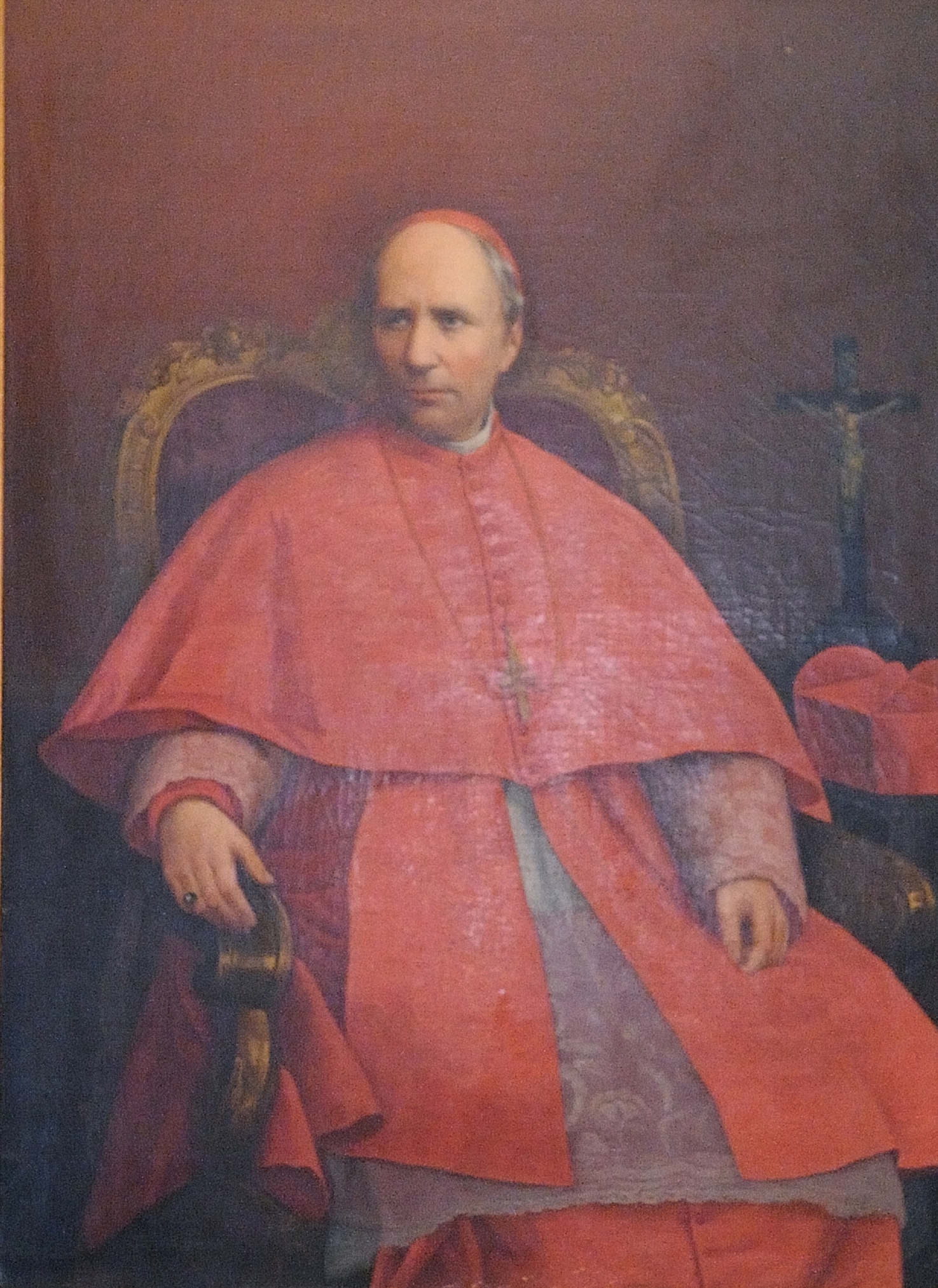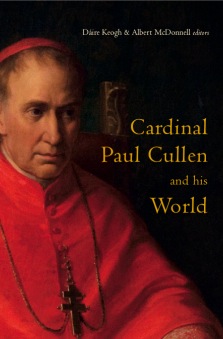Cardinal Cullen & his World
Posted on 02. Dec, 2011 in Carousel

A new book on the life, times, and influence of Cardinal Paul Cullen was launched by Professor Roy Foster of Oxford University on Thursday 23 June 2011 in the Graduate Memorial Building, Trinity College Dublin. Cardinal Paul Cullen and his world, edited by Dáire Keogh & Albert McDonnell.
 From the mid-19th century, the influence of Cardinal Paul Cullen (1803–78) was ubiquitous within Irish society and the English-speaking world. Contemporaries spoke of the ‘Cullenization of Irish society’; a Times obituary celebrated him as ‘an agent of great change’, while a critical James Joyce lampooned the cardinal as the ‘apple of God’s eye’. The book brings together 30 scholars who offer a broad perspective on the Cardinal and his age. This volume is largely based on the papers presented at conferences hosted in 2009 by St Patrick’s College Drumcondra, Dublin (founded by Cardinal Cullen) and the Pontifical Irish College, Rome (where Cardinal Cullen was rector).
From the mid-19th century, the influence of Cardinal Paul Cullen (1803–78) was ubiquitous within Irish society and the English-speaking world. Contemporaries spoke of the ‘Cullenization of Irish society’; a Times obituary celebrated him as ‘an agent of great change’, while a critical James Joyce lampooned the cardinal as the ‘apple of God’s eye’. The book brings together 30 scholars who offer a broad perspective on the Cardinal and his age. This volume is largely based on the papers presented at conferences hosted in 2009 by St Patrick’s College Drumcondra, Dublin (founded by Cardinal Cullen) and the Pontifical Irish College, Rome (where Cardinal Cullen was rector).
Contributors include:
Eamon Duffy (U Cambridge), Mary E. Daly (UCD), Virginia Crossman (Oxford Brookes U), Gerard Moran (NUIG), Liam Chambers (Mary I), S.J. Connolly (QUB), Ian Ker (Oxford U), James H. Murphy (DePaul U), Miriam Moffitt (NUIM), Joe Doyle, Anne Marie Close, Andrew Shields, Dáire Keogh (all St Pat’s, DCU), Matthew Kelly (Southampton U), Ambrose Macaulay, John Montague, Gearóid Ó Tuathaigh, Anne O’Connor (all NUIG), Christopher Korten (U Poznan), Norman Tanner SJ (Gregorian U, Rome), Ciarán O’Carroll (Clonliffe College, Dublin), Eileen Kane (UCD), Fintan Cullen (U Nottingham), Margaret Ó hÓgartaigh (All Hallows College, DCU), Colin Barr (Ave Maria U), Rory Sweetman (U Otago), Oliver Rafferty, SJ (Heythrop College) and Emmet Larkin (U Chicago).
Dáire Keogh lectures in St Patrick’s College, DCU, and is the author of, most recently, Edmund Rice and the first Christian Brothers (2008). Albert McDonnell is Vice Rector of the Pontifical Irish College, Rome.
To purchase the book visit http://www.fourcourtspress.ie/product.php?intProductID=947
Reviews
Cardinal Paul Cullen and His World
Edited by Dáire Keogh and Albert McDonnell (Four Courts Press,€55 hb)
‘The person more than any other credited with — or blamed for — ‘Romanising’ the Irish Church is Paul Cullen, Archbishop of Armagh (1849-1852), apostolic delegate, Archbishop of Dublin (1852-1878) and Ireland’s first Cardinal (1866).
It has also been asserted that he was Ireland’s most important figure between the death of O’Connell and the rise of Parnell.
”No man in the kingdom has exercised a greater personal influence, or wielded more absolute power,” proclaimed the hostile Times obituary of the Cardinal. He remains, however, an enigma; and historians have long regretted the absence of any satisfactory biography of this giant of the Irish episcopate.
Meanwhile, this new book, with its papers by 27 specialists, examines why Cullen is regarded as the prelate who influenced modern Irish society more than any other bishop. Given that his rivals for that distinction would include such names as MacHale of Tuam, Croke of Cashel, William Walsh of Dublin or John Charles McQuaid, this claim for Cullen emphasises the measure of his historical significance.
At the age of 17, Cullen went to Rome and lived there for the next 30 years as a student and professor at the College of Propaganda and later as rector of the Irish Colleges.
Like a second Patrick, he returned to Ireland with a mission — to end the squabbling among the bishops; bring discipline and uniformity of religious practice to a Catholic community emerging from the disaster and disruption of the Famine; and link the Irish Church ever more closely with the centralising policies of Rome.
That his mission was, to a considerable extent, successful is the subject matter of this important book.
The flourishing of the Catholic Church in 19th Century Ireland cannot be seen simply as the result of the ending of the persecution under the Penal Laws, or as a spiritual reaction to the horrors of the Famine. Neither can the so-called ‘Devotional Revolution’ be attributed solely to the work of Dr Cullen.
What was happening in Ireland has to be placed in the context of the remarkable revival affecting all Christian denominations in the wake of the defeat of Napoleon and the stemming of the worst features of outright hostility to Christianity by the Enlightenment and French Revolution.
Cullen’s 30 years formation in Rome coincided with this blossoming of religious renewal and the restoration of the power and authority of the pope.
These essays stress the archbishop’s involvement in the religious revival and his unquestioning loyalty to, and even veneration for, the pope’s person and office. The agenda he followed was to make Ireland conform to Rome’s system of government with the Pontiff at the head of the hierarchy, and the Roman liturgy and rituals universally accepted and practiced.
His work in Ireland began with the comprehensive reforming statutes passed at the national Synod of Thurles (1850) over which he presided. His commitment to the supreme authority of the pontiff culminated in the prominent role he played at the First Vatican Council’s proclamation of the dogma of papal infallibility in 1870.
A widely influential article by the American historian of Irish affairs, Emmet Larkin, entitled ‘The Devotional Revolution in Ireland, 1850-75’, first published in 1972, claimed that Cullen’s reforms had turned the Irish people into ‘practising Catholics’.
Bishops like Doyle of Kildare and Leighlin and Murray of Dublin, however, had preceded Cullen in introducing extensive reforms. And devotions to the Sacred Heart and the Blessed Virgin were already known in Ireland, if not yet widespread.
Although Larkin’s thesis has had to be modified, it is still generally accepted that the Cardinal spearheaded the consolidation of that ‘revolution’. And several additional devotions, litanies, novenas, confraternities, sodalities, holy pictures, scapulars, statues, retreats and missions became the hallmark of Irish Catholicism.
Under Dr Cullen, the Dublin archdiocese saw the establishment of some 20 new churches, almost 40 religious foundations, schools, hospitals and a big increase in the number of clergy, nuns and brothers. Catholicism as we came to know it had clearly emerged.
Cullen had his critics who considered him suspicious, narrow, intransigent, and intolerant. Newman, whom he had invited to be Rector of the Catholic University, complained that the Archbishop treated him and the laity not as equals but as his subjects.
Gavan Duffy emigrated from what he called ‘the blind and bitter land’, saying that he could not live in a country where Dr Cullen typified the Church. This book does not have to be read consecutively for each essay stands alone.
Not only is the central theme of Cardinal Paul Cullen and His World — the ‘Romanising’ tendency of the Irish Catholic Church — very topical indeed, but the quality of the book itself does high credit to the editors, contributors and publishers.’ Donal McCartney, The Irish Catholic (11 August 2011).
‘Cardinal Paul Cullen was the towering figure of modern Irish Catholicism and arguably the most important figure in modern Irish history between the death of Daniel O’Connell and the rise of Charles Stewart Parnell … this is a weighty and nuanced book … it contains masterful original research by some of the finest historians and scholars working on Irish religious history in its domestic and international contexts. The contributors rescue Cullen from the stereotypes, common until recently, that presented him as an anti-national “castle-bishop”, more Italian than Irish and preoccupied only with politics and ecclesiastical revival. They demonstrate that his correspondence reveals someone who defies east categorisation … it is surely legitimate to see Cullen as the individual who created many aspects of the governance and style of an Irish Catholicism that was, in the long run, exposed as too rigid, lacking sufficient humanity and too subservient to Rome. For those seeking to put that Catholic evolution into a proper historical context, this richly layered book is a very good place to start’, Diarmaid Ferriter, Irish Times WeekendReview (Sunday 10 September 2011).
‘Cardinal Paul Cullen was one of the towering figures in 19th-century Ireland and the dominant position of the Catholic Church in independent Ireland owed much to his assertion of the church’s rights under British rule. As these essays show, there was more to him than simply a churchman’, Books Ireland (September 2011).
‘Regardless of whether his legacy excites admiration or regret, historians of Irish Catholicism, church/state relations, Irish nationalism and the religious world of the Irish diaspora, as well as of wider issues of ultramontanism and the history of the papacy, invariably turn to the ‘Cullen era’ as the most crucial period from which to embark on a consideration of wider historical debates … this is an ambitious collection […and…] an important collection of essays, many of which represent scholarship of the highest calibre, covering a range of aspects of social, economic and political change in the second half of the nineteenth century. There are a series of insightful essays from a range of fine historians, which will command attention … this book can be returned to time and again and read selectively on a diverse range of topics’, Conor McNamara, History Ireland .(November/December 2011).
‘This handsome volume contains 27 essays … the contributors are a wide range of profession historians, ecclesiastical, political and social … The contents of this book cover all the areas where Cullen was most active and influential, most if not all of them controversial … While each topic is considered separately in its own context and there is no unnecessary overlapping of material, there is sufficient common ground in any particular section of the book to leave the reader with a reasonably vivid and consistent impression of Cullen’s life and work … Because this splendid book on Cardinal Cullen is hardly likely to be surpassed for some time, it can be safely recommended for libraries and anyone with a general interest in recent Irish Church history. The standard of publication is on a par with the contents. It is well laid out, well proofed, well illustrated, with clear readable print, interesting notes on the contributors, accessible footnotes at the foot of each page and a useful index’, Seosamh Ó Dufaigh, Seanchas Ard Mhacha (2011).
